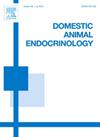Increasing cervical penetrability in sheep by long-acting treatments with oxytocin (Carbetocin) and/or prostaglandin E2 (Dinoprostone)
IF 2.1
2区 农林科学
Q2 AGRICULTURE, DAIRY & ANIMAL SCIENCE
引用次数: 0
Abstract
The aim was to study the effect of long-acting treatments with oxytocin (Carbetocin, Cb) and/or prostaglandin E2 (Dinoprostone, Dp) on cervical penetrability and collagenolysis in synchronized ewes (12 days MAP-eCG). At 42 h post eCG, ewes were treated with Cb (Group Cb, n = 6, 40 μg, i.m., Decomotón, Laboratorios Callier, Uruguay); Dp (Group Dp, n = 10, 10 mg, slow-release intravaginal device, Propess®, Ferring Pharmaceuticals Ltd., West Drayton, UK); combined Cb and Dp treatment (Group Cb+Dp, n = 8) and saline solution i.m. and a placebo intravaginal device (Group C, n = 10). Cervical penetrability increased from 0 h to 42 h post eCG (P < 0.003) in all groups, then decrease in Group C (P < 0.03) from 42 to 68 h post eCG, whereas remained unchanged in Groups Cb and Cb+Dp or increase at 54 h post eCG in Group Dp (P < 0.05). Thus, there was higher cervical penetrability in treated groups than Group C at the expected time of artificial insemination (54 h post eCG). At 54 h post eCG, collagen concentration was lower in Group Cb than in the others groups (P < 0.05), whereas the ratio between the activity of the activated and latent forms of MMP-2 was greater in Groups Cb and Cb+Dp than in Group C (P < 0.05). The increasing cervical penetrability induced by Cb, but not by Dp, could be explained by an increase in MMP-2-dependent collagen degradation. Furthermore, combined treatment with Cb and Dp did not enhance the effects induced by each hormone administered separately.
长效催产素和/或前列腺素E2(迪诺前列素)治疗提高绵羊宫颈通透性
目的是研究长效治疗催产素(carbeoxytocin, Cb)和/或前列腺素E2 (Dinoprostone, Dp)对同步母羊颈椎通透性和胶原溶解的影响(12天MAP-eCG)。eCG后42 h,母羊给予Cb (Cb组,n = 6, 40 μg, i.m., Decomotón, Laboratorios Callier,乌拉圭);Dp (Dp组,n = 10, 10 mg,缓释阴道内装置,Propess®,Ferring Pharmaceuticals Ltd, West Drayton, UK);Cb+Dp联合治疗(Cb+Dp组,n = 8)和生理盐水溶液i.m. +阴道内安慰剂装置(C组,n = 10)。心电图后0 ~ 42 h宫颈通透性增高(P <;0.003), C组降低(P <;0.03),而Cb组和Cb+Dp组在eCG后42 ~ 68 h保持不变,Dp组在eCG后54 h升高(P <;0.05)。因此,在预期人工授精时间(心电图后54 h),治疗组的宫颈通透性高于C组。心电图后54 h, Cb组胶原蛋白浓度低于其他各组(P <;0.05),而Cb组和Cb+Dp组MMP-2活性与潜伏形式的比值大于C组(P <;0.05)。Cb(而非Dp)诱导的宫颈穿透性增加可以通过mmp -2依赖性胶原降解的增加来解释。此外,Cb和Dp联合治疗并没有增强单独给药的效果。
本文章由计算机程序翻译,如有差异,请以英文原文为准。
求助全文
约1分钟内获得全文
求助全文
来源期刊

Domestic animal endocrinology
农林科学-奶制品与动物科学
CiteScore
5.50
自引率
4.80%
发文量
58
审稿时长
31 days
期刊介绍:
Domestic Animal Endocrinology publishes scientific papers dealing with the study of the endocrine physiology of domestic animal species. Those manuscripts utilizing other species as models for clinical or production problems associated with domestic animals are also welcome.
Topics covered include:
Classical and reproductive endocrinology-
Clinical and applied endocrinology-
Regulation of hormone secretion-
Hormone action-
Molecular biology-
Cytokines-
Growth factors
 求助内容:
求助内容: 应助结果提醒方式:
应助结果提醒方式:


